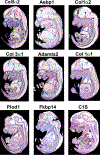Hypermobile Ehlers-Danlos syndromes: Complex phenotypes, challenging diagnoses, and poorly understood causes
- PMID: 32629534
- PMCID: PMC7785693
- DOI: 10.1002/dvdy.220
Hypermobile Ehlers-Danlos syndromes: Complex phenotypes, challenging diagnoses, and poorly understood causes
Abstract
The Ehlers-Danlos syndromes (EDS) are a group of heritable, connective tissue disorders characterized by joint hypermobility, skin hyperextensibility, and tissue fragility. There is phenotypic and genetic variation among the 13 subtypes. The initial genetic findings on EDS were related to alterations in fibrillar collagen, but the elucidation of the molecular basis of many of the subtypes revealed several genes not involved in collagen biosynthesis or structure. However, the genetic basis of the hypermobile type of EDS (hEDS) is still unknown. hEDS is the most common type of EDS and involves generalized joint hypermobility, musculoskeletal manifestations, and mild skin involvement along with the presence of several comorbid conditions. Variability in the spectrum and severity of symptoms and progression of patient phenotype likely depend on age, gender, lifestyle, and expression domains of the EDS genes during development and postnatal life. In this review, we summarize the current molecular, genetic, epidemiologic, and pathogenetic findings related to EDS with a focus on the hypermobile type.
Keywords: Ehlers-Danlos syndrome; hypermobility; musculoskeletal.
© 2020 Wiley Periodicals LLC.
Figures

References
-
- Beighton P, De Paepe A, Finidori G, et al. International nosology of heritable disorders of connective tissue Berlin. Am J Med Genet. 1986;29:581–594. - PubMed
-
- Beighton P, De Paepe A, Steinmann B, Tsipouras P, Wenstrup RJ. Ehlers-danlos syndromes: revised nosology, Villefranche, 1997. Am J Med Genet. 1998;77(1):31–37. - PubMed
Publication types
MeSH terms
Supplementary concepts
Grants and funding
LinkOut - more resources
Full Text Sources
Medical

